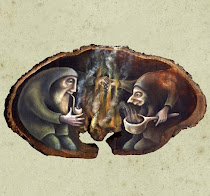KRASA ~ a name made from the Slavic roots of words for beautiful, the colour red, delight, fiery, alive, dazzling... (and which possibly ever so slightly brings to mind a certain anarcho-punk band?!).
This is the new little trio that I'm playing in (and our business card, which I've just designed). You might find us these days on Devon street corners in red outfits busking for coins in the cold December sun. We'll be performing alongside esteemed musical comrades at the Feast of Fools, of course, but you can come and see us play for free next Thursday December 13th at the Sandy Park Inn, from 7.30pm.
Here we are playing at a party last week... we all look rather serious and engrossed in getting the notes right, and there are people talking in the background (about accordions and morris minors and drinking too much, amongst other things!), but it gives you a taste.
These are two Klezmer tunes: Freilechs noch der Khupe & Papirossen.
Lisa Rowe is on fiddle, Tim Heming is on clarinet and bass, and that's me on accordion. Thanks to Pete Montanez for the video.
I'm still battling the excruciating performance nerves; it's a strange combination of wholeheartedly loving and wanting to play this music and simultaneously finding doing it in front of people terrifying. Strangely this is only when it's an "official" gig - I feel quite at home playing round a fire and thoroughly enjoy busking; perhaps I shall always remain a vagabond. But I forge on through the fear nonetheless, so come along to the pub and cheer us on if you're free next Thursday and live nearby.




















.jpg)









































































































































































































































